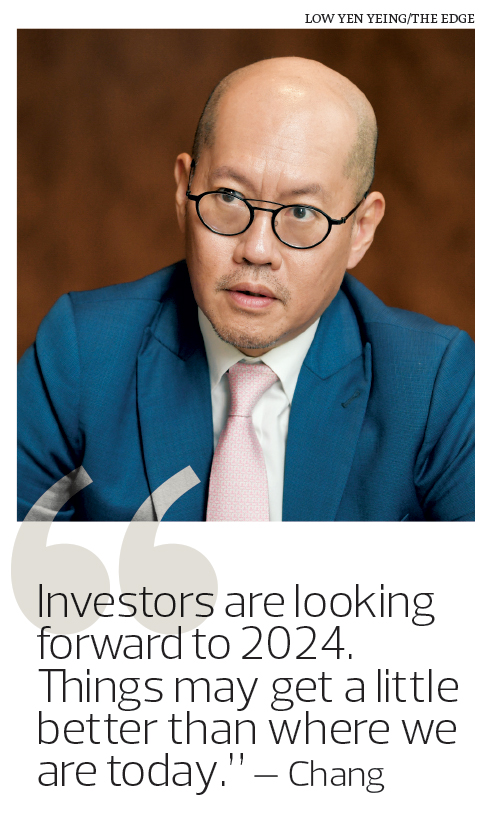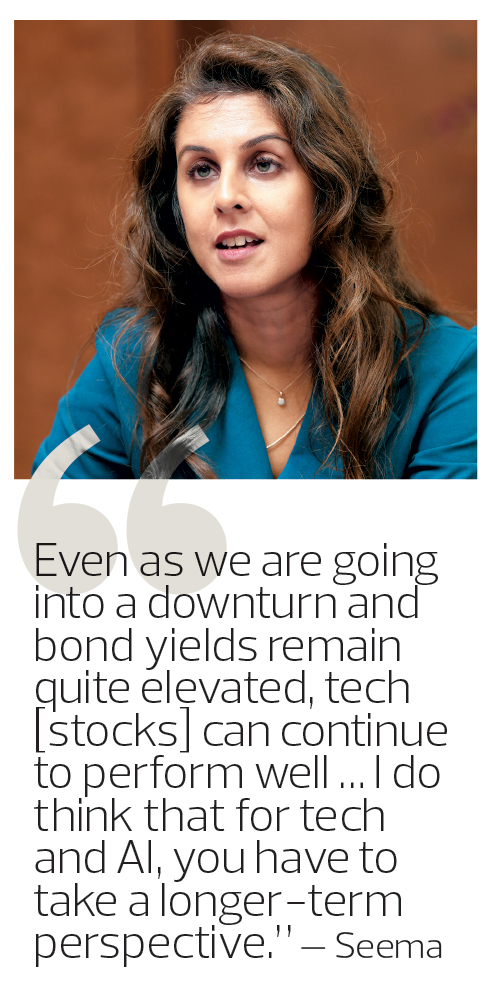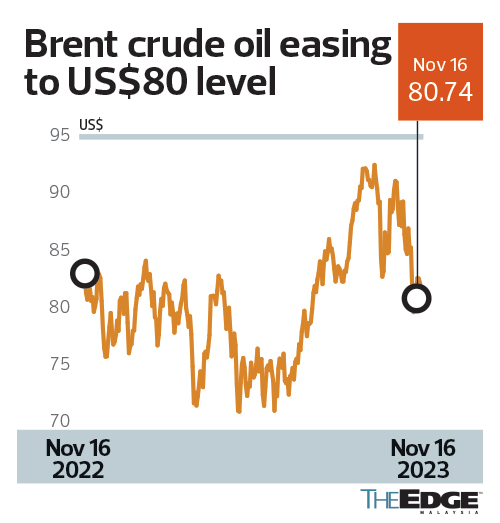
This article first appeared in Capital, The Edge Malaysia Weekly on November 20, 2023 - November 26, 2023
TECHNOLOGY has been the outperformer in the global equity market this year, as evident from the 34.7% gain achieved by the tech-heavy US Nasdaq Composite Index — its longest streak of gains in two years. Notably, the Nasdaq rally has outpaced that of all regional key indices so far this year.
Moving into 2024, experts at asset management company Principal Asset Management Bhd are of the view that tech will remain one of the key investment themes, fuelled by positive chip restocking activity.
Energy is also a sector to watch, as current oil prices are perceived to be underpriced in view of the geopolitical environment and tight market supply, they add.
Principal Asset Management chief global strategist Seema Shah is optimistic about 2024, even though a global slowdown is imminent. Tech stocks will remain on her investment radar.
“Even as we are going into a downturn and bond yields remain quite elevated, tech [stocks] can continue to perform well. They are very expensive — that goes without a doubt — and valuations are very stretched, [but] they are a little bit cheaper than they were [before].
“I do think that for tech and AI (artificial intelligence), you have to take a longer-term perspective. And even in the short term, one of the things that we are seeing is when investors consider tech, it has to be the large-cap and not the smaller tech companies because I think there are still some concerns in that space,” she tells The Edge in an interview.
Specifically on local tech stocks, Patrick Chang, chief investment officer (equities) at Principal Southeast Asia, is positive on the order book replenishment progress, though Malaysia’s manufacturing Purchasing Managers’ Index (PMI) remains below the 50-point threshold. A reading above 50 signifies sectoral expansion, while that below 50 indicates contraction.
“We just did a tech tour in Penang and Johor about a month ago. And the sense we’re getting is that the order book [of the tech companies] is starting to be replenished. If you look at the most cyclical electronic countries such as Vietnam and Singapore, their PMIs are above 50 today. These are what we call the green shoots of exports. Therefore, I think there is a ray of light in terms of how we perceive the chip restocking happening.
“The fourth quarter is always a restocking period for chipset manufacturers, so I think that’s where we are going to get that tailwind in terms of export being a supportive generator of GDP (gross domestic product),” he says.
On the energy sector, Seema believes the current oil price of about US$80 a barrel is underpriced. “We are a little bit surprised by how low oil prices are today. And we have a long-term strategic exposure to commodities. It is very volatile, [but] it is a good value play,” she says, adding that her end-2024 oil price target is US$85 a barrel.
“If anything, the risk to that has to be tilted to the upside,” she continues.
While the global economy is set to experience a slowdown in the beginning of 2024, Seema is reluctant to call a recession for the US economy. “It’s more of a short, shallow downturn, with a continued increase in unemployment. Nothing too drastic, but enough to trigger some concerns.”
That said, she notes the positive part is the deceleration of inflation to a level that central banks can be somewhat comfortable with. “As a result, we are expecting rate cuts in developed markets in the early second half of next year, starting with the US Federal Reserve and followed pretty quickly by the ECB (European Central Bank).”
She believes the expected slight monetary easing next year will draw investor interest to equities. “You would have some monetary easing, [but] nothing drastic again. Monetary easing has typically and historically been a trigger for fairly good performance for equities.”
Early this month, the Fed kept the key federal funds rate in a target range of between 5.25% and 5.5%.
Balancing investment choices between equities and fixed income
Given all the aforementioned developments, one may wonder how to allocate capital to equities and fixed income.
Taking a nine-month horizon as an example, Seema says, “Because of the volatility that we are expecting to see, we are actually sitting at around neutral with a slight preference for equities in the near term. I think the equity market is celebrating the fact that we are close to the end of tightening. We are not seeing any weakening in the economic cycle. Right now, we are in a sweet spot.
“[But] I don’t think the sweet spot will last for very long. It might only last till the beginning of next year. So from that perspective, maybe it is a slight and very slow overweight on equities,” she adds.
While US 10-year Treasury yields remain elevated at around 4.45%, Seema does not think it is too much of a concern. Instead, it benefits fixed income investors.
“We’ve not detected any signs of financial and systemic risks, even with the yields at around the 5% level. I would actually say that a 4.5% to 5% level is kind of where bond yields in the long term are going to settle at, because the neutral rate is higher. It’s a process of adjustment. Investors are adjusting to the idea that yields are kind of sustainably higher than [where] they were previously.
“Growth is fairly strong. As long as you’re not looking at a deep recession, then yields should be a little bit higher. I think in the near term, you could see yields coming down a little bit further, certainly [as] central banks cut rates when you get a bit of a weakness coming through. But the floor rate will be higher than it was,” she says.
Come early next year, Seema believes that investors will need to reset their earnings expectations in view of a potential global slowdown.
On the escalating war between Israel and Hamas in Gaza, she observes that the key impact will be on global oil prices, which have yet to see any significant movements since Hamas’ attack on Israel on Oct 7.
Government reforms to support Malaysian equities
From a valuation perspective, Chang notes that the Malaysian market remains undemanding, but with the reforms the government is embarking on, he says local equities could be an interesting outlier in Asia.
“You may say it’s cheap for a reason because the risk premium is a little bit higher. But if we [manage to] execute on reforms, the NETR (National Energy Transition Roadmap) and other good things — what I call a more stable government environment — then things may [start to improve].
“Despite all the geopolitical risks, I think markets are starting to price [in] a little bit of reforms and energy prices being high. Investors are looking forward to 2024. Things may get a little better than where we are today,” he opines.
Meanwhile, he has a word of caution for those who invest in construction stocks, given the sector’s cyclical nature. “I think there are opportunities in the construction sector, [but] it has run up a lot in the near term. We are potentially in the mid-cycle of construction.”
Construction is one of the best-performing sectors on Bursa Malaysia with a year-to-date gain of 23.2%, compared with the benchmark FBM KLCI’s 1.9% decline.
For Chang, Malaysia, Vietnam and Indonesia are the “comeback kids”.
“Vietnam has always been my favourite market. It came off because of all the currency issues. Indonesia is going into an election next year, and I’m hoping it will correct even more and that will give us an opportunity to buy. At home in Malaysia, it is a little bit more ‘constructive’ because it has been beaten up for too long,” he says.
Save by subscribing to us for your print and/or digital copy.
P/S: The Edge is also available on Apple's App Store and Android's Google Play.




